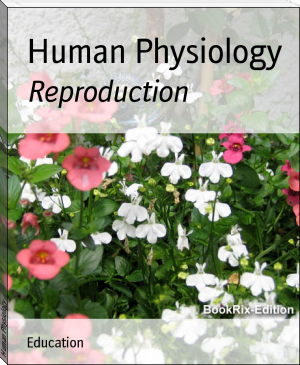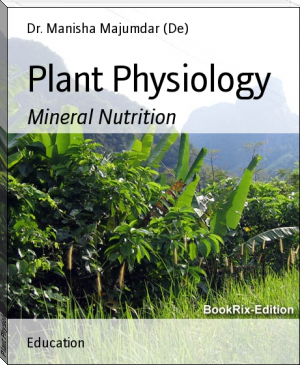Human Physiology by Dr. Manisha Majumdar (De) (best desktop ebook reader .TXT) 📖

- Author: Dr. Manisha Majumdar (De)
Book online «Human Physiology by Dr. Manisha Majumdar (De) (best desktop ebook reader .TXT) 📖». Author Dr. Manisha Majumdar (De)
Terms to remember
Actin
One of the major proteins that makes up vertebrate muscle
Creatine phosphate
This high energy compound present in the muscle and it helps to convert ADP to ATP.
Ligament
Connective tissue of great tensile strength attaches bone to bone.
Myology
Study of muscles
Myosin
One protein component of microfilaments, a principal component of vertebrate muscles
Myosin ATPase
An enzyme that hydrolyzes ATP into ADP and Pi with the release of energy
Neuromuscular junction
The structure formed when the tips of axon contact (innervate) a muscle fiber.
Sarcolemma
The specialized cell membrane in a muscle cell
Sarcomere
Fundamental unit of contraction in skeletal muscle, repeating bands of actin and myosin that appear between two Z lines
Summation
Repetitive activation of the motor neuron resulting in maximum sustained contraction of muscle
Synovial fluid
Fluid present at the synovial joints in the synovial cavity such as elbow, shoulder etc.
Tendon
A collagen-containing band of tissue that connects a muscle with a bone
Questions for self- assessment
Very short answer questions 1 mark each
What is muscle twitch? (H.P.S.E.B. 2000) Which myofilaments slide in a sarcomere during contraction? What lubricates the freely movable joints at the shoulder? (C.B.S.E. 1994) Name the chemical that causes fatigue in the muscle. (C.B.S.E. 1997) Name the kind of skeleton joint which permits movements in a single plane only.(C.B.S.E. 1995) Name the functional contractile unit of the muscle. (C.B.S.E. 1997) Which type of movable joint is the shoulder joint? (C.B.S.E. 1996) Which type of movable joint makes the hip joint? (C.B.S.E. 1996) Mention one significant difference between muscle twitch and tetanus.(C.B.S.E. 1995) What property of muscle fiber enables them to cause movement? (C.B.S.E. 1995) Name the filaments that cause cross-bridges during muscle contraction. (C.B.S.E. 1995) Name the tissue which connects muscle to a bone. (C.B.S.E. 1995) Which term do you use for the muscles, which draw a bone away from the body midline? (C.B.S.E. 1994) Name the thin and thick protein of muscle fibers. (C.B.S.E. 1993, 95) Name two special proteins which constitute the contractile filaments of muscle fibers. (C.B.S.E. 1992) Give the term for a continued state of contraction caused by many rapidly repeating stimuli in a muscle. (C.B.S.E. 1992) What are two types of straited muscle filaments? (C.B.S.E. 1992) Give one example each of fibrous joint and cartilagenous joints.(C.B.S.E. 1992) Name the type of movable joint at the knee or at the elbow.(C.B.S.E. 1991, 93, 95) What is synovial fluid? (C.B.S.E. 1987) Name the two types of myofilaments in a sarcomere. What is myoglobin? Name the protein which constitutes I-band and A-band. Name one set of muscles which work antagonistically. Name the theory proposed by Huxley and others for the muscle contraction.
Answer
(1) See text. (2) Actin myofilaments. (3) Synovial fluid. (4) Lactic acid (5) Hinge joint. (6) Sarcomere. (7) Ball and socket type. (8) Ball and socket type. (9) See text. (10) Excitability and conductivity. (11) Actin and myosin filaments. (12) Tendon. (13) Abductors. (14) Myosin. (15) Actin and myosin. (16) Tetanus. (17) Actin and myosin. (18) Between bones of cranium, joints between the centra. (19) Hinge joint. (20) A lubricating fluid present in synovial cavity of movable joints. (21) Primary, thick or myosin, myofilaments and secondary, thin or actin myofilaments. (22) When red blood cell present in the muscle then it is called myoglobin. RBC of muscle combine with O2 to form oxy-myoglobin. This oxy-myoglobin release O2 during muscle contraction and become myoglobin. (23) Actin and myosin. (24) Biceps and triceps. (25) Sliding filament theory of muscle contraction.
Short answer questions 2 marks each
Which causes muscle fatigue? How is it removed? (H.P. 2002) Why are movement and locomotion necessary among animal? Differentiate between tendon and ligament. What actually leads to shortening of a sarcomere? What is summation? Explain important features of synovial joints. What is joint? Give examples of ball and socket and hinge joint. Explain and differentiate the terms movement and locomotion. Where from muscle gets energy for contraction? Differentiate between sarcoplasm and sarcolemma. What are isotonic and isometric contractions? Why are muscles rich in the compound creatin phosphate? Differentiate between fibrous joints and cartilagenous joints. What cause muscle fatigue? How it is removed? Differentiate between actin and myosin. What is summation? What is myosin ATPase? Differentiate between H-band and M-band. What is knee joint? What is sarcomere?
Short answer questions 3 marks each
Explain the sliding filament theory of muscle contraction. (C.B.S.E. 2001) What make the synovial joint freely movable? List the various types of synovial joints. (C.B.S.E. 1999) Explain the principle of antagonistic muscles. Give one example of such muscles.(C.B.S.E. 1999) Write short note on muscle fatigue. What is the biological significance of (a) myoglobin (b) phospho creatinine (c) red bone marrow. How does the body muscle act? What is the significance of locomotion? Write three points about it. Differentiate between red and white muscle. Distinguish between (a) Fibrous joints and cartilagenous joints. (b) Active and myosin. (c) Isotonic and isometric contraction of muscle. What is antagonistic muscle? Explain with example. How are red muscle fibers specialized for sustained work over a prolonged period? How does calcium affect the process of muscle contraction? How does skeletal muscle contract? How are thick and thin filaments arranged in a muscle fiber? What are biceps and triceps?
Long answer questions 5 marks each
1. Write briefly the biological importance of the following :
(a) Myoglobin
(b) Active and myosin filament
(c) Synovial joints
(d) Fibrous joints
(e) Lactic acid (C.B.S.E. 1999)
2. What chemical changes occur during contraction of a skeletal muscle? (C.B.S.E. 1995)
3. Describe the various kinds of skeletal joints in human body according to their mobility, giving one example each. (C.B.S.E. 1994)
4. How does the muscle shorten during its contraction and lengthen during its relaxation? Explain with diagram. (C.B.S.E. 1991)
5. How is the structure a sarcomere suitable for the contractility of the muscle? Explain its function according to sliding filament theory. (C.B.S.E. 1990)
6. Differentiate between
(a) Tendon and ligament.
(b) White and red muscle fibers.
(c) Fixed joints and synovial joints.
(d) Actin and myosin.
7. Enumerate the events of muscle contraction.
8. How is energy supplied for muscle contraction.
9. Describe the structure of striated muscle.
10. Name only different types of joints.
11. Distinguish between
(a) Muscle twitch and tetanus
(b) Ball and socket-point and hinge joint. (H.B.S.E.B. 2001)
12. Answer the following briefly :
(a) How does the muscle shorten during its contraction and lengthen during its relaxation?
(b) How biological functions are served by the skeletal system?
(c) Why a red muscles fiber can work a prolonged period while a white muscle fiber suffers from fatigue after a shorter work?
(d) Where from the muscle gets energy for its contraction. (N.C.E.R.T.)
13. Match the items of Column A with B.
Column A
Column B
1.
Myoglobin
Skeletal muscle
2.
Actin
Muscle fiber filament
3.
Planar
Neurotransmitter
4.
Acetylcholine
Red muscle fiber
5.
Prime movers
Synovial joint
14. Differentiate between red and white muscle fibers with their examples.
15. Enumerate the events of muscle contraction.
16. Write briefly the biological importance of the following :
(a) Fibrous joints;
(b) Synovial joints;
(c) Actin and myosin filaments;
(d) Lactic acid;
(e) Myoglobin;
17. What is a joint? Write its type with examples.
18. Describe in brief sliding-filament theory of muscle contraction.
19. Write the differences between :
(a) Actin and myosin;
(b) Red and white muscle;
(c) Movable and immovable joints.
20. Match the items of Column A with B.
Column A
Column B
1.
Myoglobin
Smooth muscle
2.
Involuntary
Tropomyosin
3.
Third class lover
Red muscle
4.
Thin filament
Imprint
Publication Date: 03-07-2016
All Rights Reserved
 The desire to acquire knowledge about the surrounding world and human society is quite natural and understandable for a person. Life is so developed that an uneducated person will never occupy a high position in any field. Humanity in its mass, and each person individually, develops objectively, regardless of certain life circumstances and obstacles, but with different intensity. The speed of development depends on the quality of training.
The desire to acquire knowledge about the surrounding world and human society is quite natural and understandable for a person. Life is so developed that an uneducated person will never occupy a high position in any field. Humanity in its mass, and each person individually, develops objectively, regardless of certain life circumstances and obstacles, but with different intensity. The speed of development depends on the quality of training.




Comments (0)